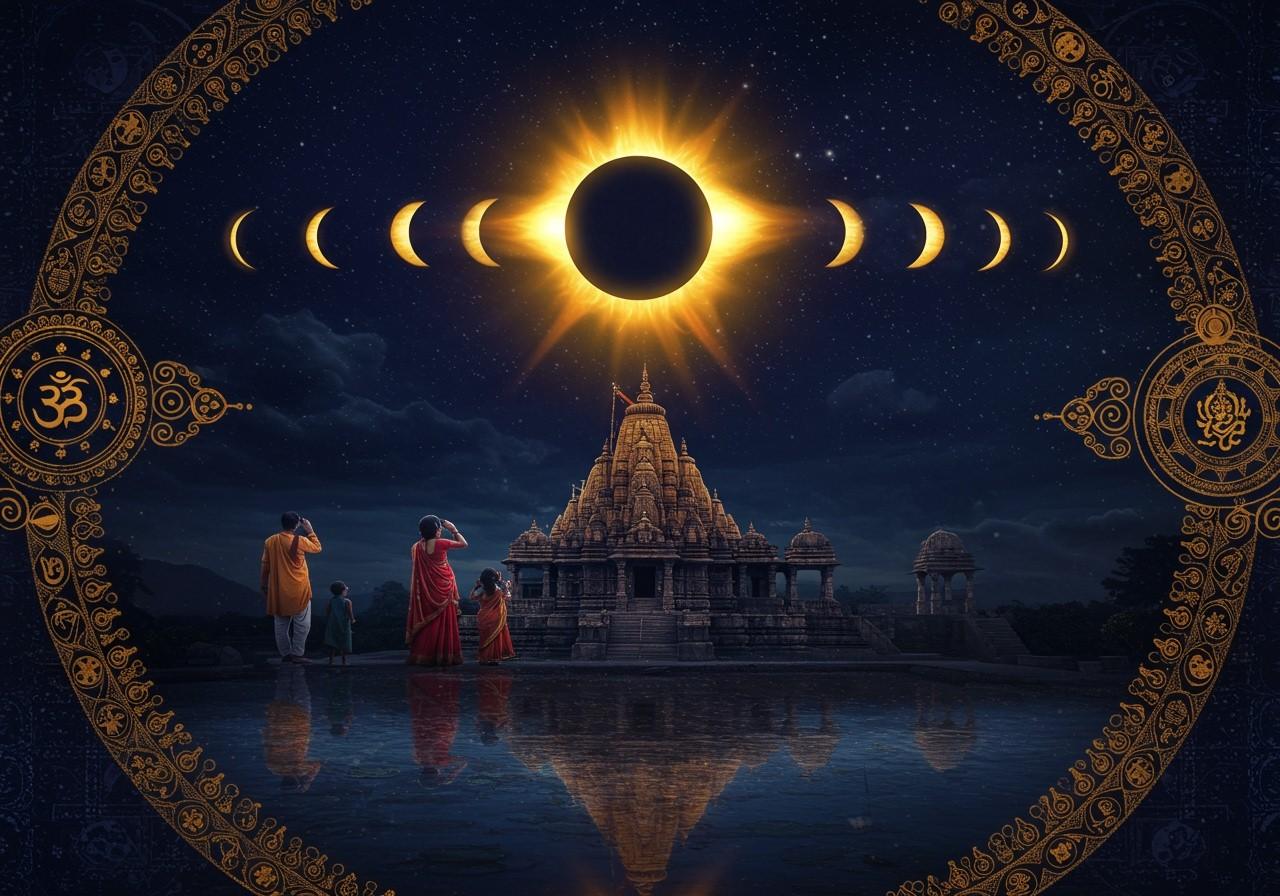
Surya Grahan, or solar eclipse, has been a significant astronomical event in Indian culture for centuries. This article explains what a Surya Grahan is, how it occurs, its cultural importance, and safe viewing practices. We’ll also touch upon the upcoming Surya Grahan in 2024.
What is Surya Grahan?
A Surya Grahan, or solar eclipse, happens when the Moon passes between the Earth and the Sun, partially or totally obscuring the Sun’s light from certain areas on Earth. This alignment occurs during the new moon phase, approximately every six months, when the Moon’s orbit is closest to Earth’s orbital plane. There are different types of solar eclipses: partial, total, and hybrid. The darkest point of a solar eclipse is only visible from specific locations.
How Surya Grahan Happens
A solar eclipse is a result of the precise alignment of the Sun, Moon, and Earth. The Moon’s orbit and specific conditions must be just right for a solar eclipse to occur. Different locations on Earth experience different types of eclipses based on their position.
Types of Eclipses
-
Total Solar Eclipse: This occurs when the Moon is close enough to Earth to completely cover the Sun, resulting in the brief period of totality where the Sun’s corona becomes visible.
-
Partial Solar Eclipse: In a partial eclipse, the Moon only partially obscures the Sun’s disk, creating a crescent shape. The amount of coverage varies depending on the observer’s location.
-
Annular Solar Eclipse: This happens when the Moon is too far from Earth to completely cover the Sun. It creates a “ring of fire” effect, where the Sun’s outer edge remains visible around the Moon.
-
Hybrid Solar Eclipse: A less common type where the eclipse appears as annular at some points on Earth and total at others.
Cultural Significance of Surya Grahan
Surya Grahan holds deep cultural and religious significance in India. Many rituals, including fasting, chanting mantras, and bathing in sacred rivers, are traditionally observed during a solar eclipse. Beliefs and myths surrounding Surya Grahan are prominent in Hinduism and other Indian religions. Astrology considers solar eclipses influential events, impacting people’s lives. Legends and stories from various Indian regions often feature solar eclipses, adding to their mystique.
Learn more about Hindu Philosophy. Explore the meanings of Hindu Symbols.
Scientific Observations and Safety Measures
Scientists study solar eclipses to gain insights into the Sun and Moon. Important discoveries have been made during past eclipses. Using proper eye protection during a Surya Grahan is crucial to avoid eye damage.
Safe Viewing Tips
-
Eclipse Glasses: Wear special-purpose solar eclipse glasses that meet the ISO 12312-2 international safety standard. Regular sunglasses are not sufficient.
-
Pinhole Projectors: Create a simple pinhole projector to indirectly view the eclipse. This method projects an image of the Sun onto a surface.
-
Telescopes with Filters: If using a telescope, ensure it has a properly fitted solar filter to protect your eyes.
Surya Grahan 2024
The next Surya Grahan will occur in 2024, specifically on April 8th. It will be an annular eclipse, best viewed from southern parts of India. Learn more about the geography mentioned in the Ramayana.
Preparing for the Eclipse
-
Viewing Locations: Find a location with a clear view of the sky, free from obstructions like buildings or trees.
-
Equipment: Gather your viewing equipment beforehand, whether it’s eclipse glasses, a pinhole projector, or a telescope with a solar filter.
-
Special Events: Check for community gatherings or cultural events related to the eclipse in your area.
How Poojn.in Helps During Surya Grahan
Poojn.in, India’s leading online store for cultural goods and services, offers a wide selection of authentic puja items and materials specifically for Surya Grahan rituals. Tulsi Kanthi Mala is traditionally worn for protection, while Alta Pata is used for various rituals. We also offer Gongadi Asan for comfortable seating during ceremonies. Poojn.in provides 28-Batti Diya, copper vessels for water storage, darbha grass (kusha), and complete puja samagri kits. We also offer special daan items like rice, black til (sesame), and vastra (clothing), traditionally given during this period. All products are quality-assured and delivered promptly, so you can prepare for the eclipse.
Conclusion
Surya Grahan is more than just an astronomical occurrence; it’s an integral part of Indian culture and traditions. Understanding its science, cultural significance, and safe observation methods allows us to appreciate this phenomenon fully. As we anticipate the Surya Grahan in 2024, let’s prepare to observe it safely and share this unique experience with our loved ones, embracing the wonders of nature and the rich traditions associated with it. Read about Hanuman’s Journey and Lord Rama’s Ideal Leadership.
FAQs on Understanding Surya Grahan (Solar Eclipse)
What is Surya Grahan? Surya Grahan, or a solar eclipse, happens when the Moon passes between the Sun and Earth, blocking sunlight and casting a shadow on Earth.
How does Surya Grahan happen? Surya Grahan occurs due to the alignment of the Sun, Moon, and Earth during the new moon phase when the Moon’s orbit intersects Earth’s orbital plane.
Why does Surya Grahan occur? The Moon’s orbit around Earth causes it to occasionally align perfectly with the Sun and Earth, resulting in a solar eclipse.
When is the next Surya Grahan? The next Surya Grahan is on April 8, 2024.
Can Surya Grahan be seen everywhere? No, Surya Grahan is only visible in specific regions where the Moon’s shadow falls on Earth. The type of eclipse (total, partial, or annular) seen also varies by location.
What are the types of Surya Grahan? There are four types: total, partial, annular, and hybrid. A total eclipse completely obscures the Sun, a partial eclipse covers only a portion, an annular eclipse leaves a “ring of fire,” and a hybrid eclipse transitions between annular and total.
Is it safe to look at Surya Grahan? Never look directly at the Sun during a solar eclipse without proper eye protection. Use ISO-certified solar viewing glasses, a pinhole projector, or other indirect methods.
How long does Surya Grahan last? The duration varies depending on the type of eclipse and the observer’s location, ranging from a few minutes to several hours for the partial phases.


